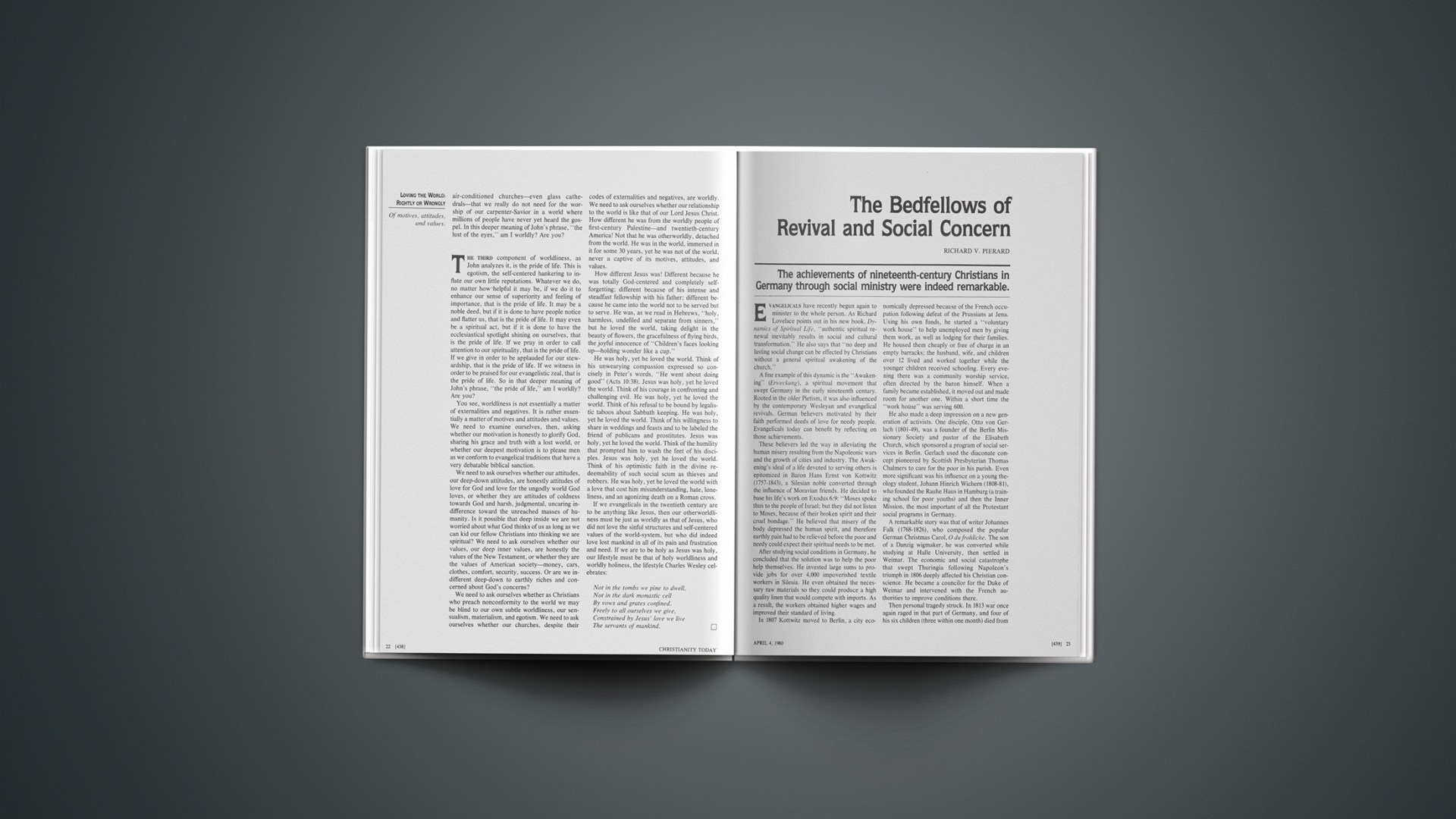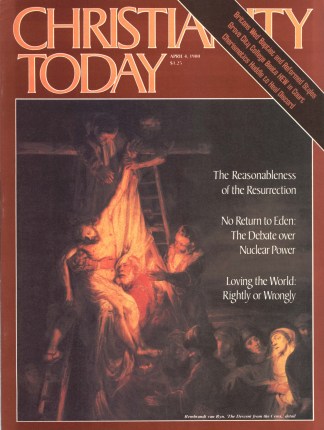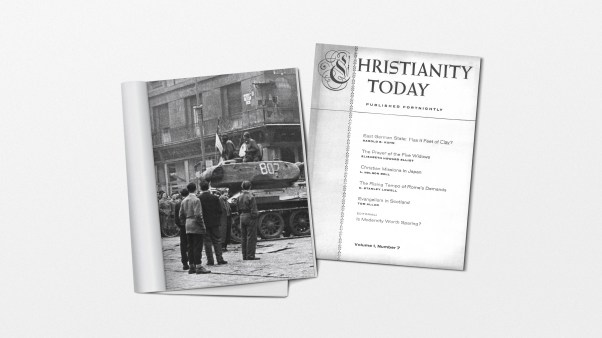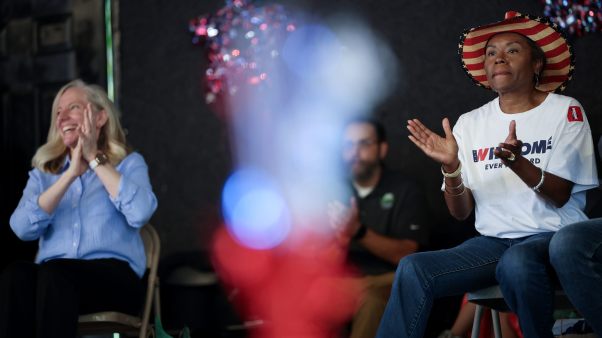The achievements of nineteenth-century Christians in Germany through social ministry were indeed remarkable.
Evangelicals have recently begun again to minister to the whole person. As Richard Lovelace points out in his new book, Dynamics of Spiritual Life, “authentic spiritual renewal inevitably results in social and cultural transformation.” He also says that “no deep and lasting social change can be effected by Christians without a general spiritual awakening of the church.”
A fine example of this dynamic is the “Awakening” (Erweckung), a spiritual movement that swept Germany in the early nineteenth century. Rooted in the older Pietism, it was also influenced by the contemporary Wesleyan and evangelical revivals. German believers motivated by their faith performed deeds of love for needy people. Evangelicals today can benefit by reflecting on those achievements.
These believers led the way in alleviating the human misery resulting from the Napoleonic wars and the growth of cities and industry. The Awakening’s ideal of a life devoted to serving others is epitomized in Baron Hans Ernst von Kottwitz (1757–1843), a Silesian noble converted through the influence of Moravian friends. He decided to base his life’s work on Exodus 6:9: “Moses spoke thus to the people of Israel; but they did not listen to Moses, because of their broken spirit and their cruel bondage.” He believed that misery of the body depressed the human spirit, and therefore earthly pain had to be relieved before the poor and needy could expect their spiritual needs to be met.
After studying social conditions in Germany, he concluded that the solution was to help the poor help themselves. He invested large sums to provide jobs for over 4,000 impoverished textile workers in Silesia. He even obtained the necessary raw materials so they could produce a high quality linen that would compete with imports. As a result, the workers obtained higher wages and improved their standard of living.
In 1807 Kottwitz moved to Berlin, a city economically depressed because of the French occupation following defeat of the Prussians at Jena. Using his own funds, he started a “voluntary work house” to help unemployed men by giving them work, as well as lodging for their families. He housed them cheaply or free of charge in an empty barracks; the husband, wife, and children over 12 lived and worked together while the younger children received schooling. Every evening there was a community worship service, often directed by the baron himself. When a family became established, it moved out and made room for another one. Within a short time the “work house” was serving 600.
He also made a deep impression on a new generation of activists. One disciple, Otto von Gerlach (1801–49), was a founder of the Berlin Missionary Society and pastor of the Elisabeth Church, which sponsored a program of social services in Berlin. Gerlach used the diaconate concept pioneered by Scottish Presbyterian Thomas Chalmers to care for the poor in his parish. Even more significant was his influence on a young theology student, Johann Hinrich Wichern (1808–81), who founded the Rauhe Haus in Hamburg (a training school for poor youths) and then the Inner Mission, the most important of all the Protestant social programs in Germany.
A remarkable story was that of writer Johannes Falk (1768–1826), who composed the popular German Christmas Carol, O du frohliche. The son of a Danzig wigmaker, he was converted while studying at Halle University, then settled in Weimar. The economic and social catastrophe that swept Thuringia following Napoleon’s triumph in 1806 deeply affected his Christian conscience. He became a councilor for the Duke of Weimar and intervened with the French authorities to improve conditions there.
Then personal tragedy struck. In 1813 war once again raged in that part of Germany, and four of his six children (three within one month) died from epidemic diseases that followed in its wake. As Falk saw large numbers of orphaned children roaming the city streets and country lanes, he began to gather them into his modest dwelling, saying, “God has taken my four angels and spared me that I might be your father.”
Earlier that year Falk had founded the Society of Friends in Need to aid local peasants in reconstruction. After his children died, the society concentrated on finding homes for orphans. He opened a “Reformatory” in his house to provide shelter and education for delinquent vagabonds, some of whom he had himself plucked from local jails. Because resentful neighbors opposed the presence of these ragamuffins in their genteel residential area, Falk finally purchased and remodeled a rundown castle in the town, and called it “Lutherhof.” Besides this, he trained school teachers to work with poor children and placed hundreds of youths as apprentices with local craftsmen.
Falk believed that the root of societal evil was not ignorance but sin, and that it was necessary to implant in young people the secret of a religious life. Education, he felt, was not the true way to a moral life and to reform of the world, so along with the three “R’s” he taught that a Savior died even for the outcasts of society. The unwanted children came in touch with genuine love and learned how to make a living. The foundation in Weimar survived long after Falk’s death, a sign of the life-changing power of the gospel. Falk’s model of linking shelter and care with elementary education was followed by Protestant child welfare work in nineteenth-century Germany.
Amalie Sieveking (1794–1859) was the first woman in this period to gain distinction in humanitarian work. She belonged to a prominent Hamburg family, possessed a pietistic faith, and had ties with English evangelicals. She demonstrated the depth of her concern during a cholera epidemic by laboring selflessly in the hospitals to help disease victims. In 1832 she formed the Women’s Association for Care of the Poor and Sick, a group of Christians who distributed food and visited those in need. When a serious fire ravaged the city in 1842, she and her coworkers provided food and shelter for the victims. Although she restricted her own activity to Hamburg, women in other cities formed similar groups.
One of the major “Awakened” activists was Theodor Fliedner (1800–64). He started the “deaconess” movement, which decisively opened up the field of philanthropic work in the German Protestant church to women. Upon completing his theological studies, he accepted a call from a tiny congregation at Kaiserswerth, a village on the Rhine just north of Düsseldorf. Shortly after he arrived in 1822, the town’s main industry, a textile mill, closed down and caused his parishioners severe hardship. To keep the struggling church afloat, he traveled widely, even to Holland and England, seeking funds.
The successes of the British evangelicals impelled Fliedner to action in his own country. He began to preach in the Düsseldorf jail and to visit individual prisoners. In 1826 he formed the first prison reform group in Germany, the Prison Society of the Rhineland and Westphalia. It sought to provide pastors and teachers for the prisons, segregated inmates according to their ages and nature of their crimes, gave them work to do while in jail, and helped them get a new start after release. The society preached that the purpose of detaining criminals should be to reform rather than to avenge them. Fliedner was particularly concerned about female prisoners, and in 1833 he opened the first “Magdalene Home” for women ex-convicts and prostitutes in Kaiserswerth.
During his travels he noticed the achievements of Elizabeth Fry and the Dutch Mennonite practice of using deaconesses to minister to the poor. He also recognized that women served in the early church (especially Phoebe, whom Paul called a “deacon” in Romans 16:2), but the medieval nun seemed to be an unfortunate replacement for the female diaconate. Moreover, Count Recke had publicly called for the restoration of the “office of deaconess,” and Amalie Sieveking was an ideal model of devoted service. Fliedner’s wife Friederike (1800–42), who before their marriage worked in a home for abandoned children, played a major role in his decision to start a deaconess order. She helped energetically in his various ministries and was the moving spirit behind the Kaiserswerth Deaconess Institute.
Wherever he went, Fliedner recognized the difficulties facing the sick due to inadequate health care facilities and nursing staffs. In 1836 he decided to purchase a large house to serve as a training hospital for nurses. The idea of preparing young women for service in hospitals quickly found approval in the Awakened circles, and from all over Germany women began making their way to Kaiserswerth. Within five years the number of “nursing sisters” had reached 29, and by 1900 over a thousand.
Out of the nursing school emerged the first “mother house,” since Fliedner was firmly committed to the deaconess concept. The nursing sisters would serve the church by caring for the sick and infants and be equal in status to the male diaconate. Although Fliedner saw this as the restoration of an apostolic church practice, historian Erick Beyreuther comments that this was really a new idea animated by the spirit of the Reformation. With the breakup of the old social order caused by the industrial revolution, new avenues for purposeful service by women were needed and the female diaconate offered one possibility.
The deaconess order, with its overseers and stress on obedience, reflected the traditional German pattern of subordination. The women lived in a community, but not a democratic one. Assignments were made by the order’s authorities to whatever position and place of service they so determined. The women were not allowed to marry because Fliedner believed this would interfere with their flexibility. On the other hand, the vows of obedience, faithfulness, devotion to her calling, and willingness to remain in the sisterhood were not as binding as those of a Roman Catholic order, and they did not lead to a contemplative existence.
The sisters were schooled in nursing, kitchen work, gardening, and child rearing, with special attention to their spiritual life. They wore simple clothing, much like the average bourgeois woman of the time. The color blue was chosen because it allegedly was worn by temple personnel in Bible times. The garb cultivated modesty and simplicity, guarded against vanity, and was utilitarian.
Fliedner tried to work closely with the ecclesiastical structures, but most church leaders, having succumbed to the deadening spirit of rationalism, had little sympathy with ventures that flowed from grassroots pietistic and revivalistic elements. As a result, he had to turn to the Prussian state for legal recognition and financial support. He also spent much time soliciting funds from individuals and congregations. Fliedner’s ministry, like those of Hudson Taylor and George Mueller, was a prototype of the “faith mission” concept. Since German Protestant churches were divided into regions and territories and many of their leaders had no interest in spiritual questions, all social service agencies (and foreign missionary societies as well) had to be private foundations that raised their own support.
Fliedner influenced other notables such as Friedrich von Bodelschwingh (1831–1912), director of the world famous mental institution at Bethel; Wilhelm Lohe (1804–72), who organized a confessional Lutheran diaconate at Neuendettelsau; and Florence Nightingale (1820–1910), an English evangelical who led in the development of modern nursing. Even the so-called free churches, such as the Baptists, began to use deaconesses. Fliedner traveled around Germany establishing new mother houses, and even transplanted the Kaiserswerth model to the Near East and the United States.
The deaconess movement was significant because it enabled Christian women to help relieve poverty, sickness, and other human distress. More important, it allowed them to be active in the public life of the church. Since it involved forms of service that often went beyond traditional roles, the movement was a step forward in the women’s liberation process. It accurately reflected the desire of revived believers to apply their faith to practical human needs.
It is easy to criticize the efforts of these German Christians from today’s perspective. Of course they were too individualistic and tied to the existing social order. Yet, considering the nature of the times and the environment in which they functioned, their achievements were indeed remarkable. In an age when few cared about the suffering of others, these Christians cared. While most others ignored the problems, they acted. Although the flame of an active Christian faith had died down, theirs was fanned by the wind of revival. Thus we should pay our respects to these stalwart giants of the faith and allow them to challenge us to perform greater deeds for our Lord.
Kampuchea
Selfishness …,
The cause of all this,
Suffering, hunger and pain,
War, the many silent slain,
Guns fire and mines explode,
A child’s tears linger on a thin face,
Stumbling footsteps over a barren waste,
Glazed eyes, feverridden …,
They have no hope at all,
Skeletons move and bodies shake,
Babies die and spirits ache,
People pass away, alone at the last,
But no one knows or pretends to weep,
Their hearts are gone, the wound is deep,
Greed has crushed this tiny land,
And balances it in his cruel hand.
RUTH ATKINSON
Carl F. H. Henry, first editor of Christianity Today, is lecturer at large for World Vision International. An author of many books, he lives in Arlington, Virginia.










